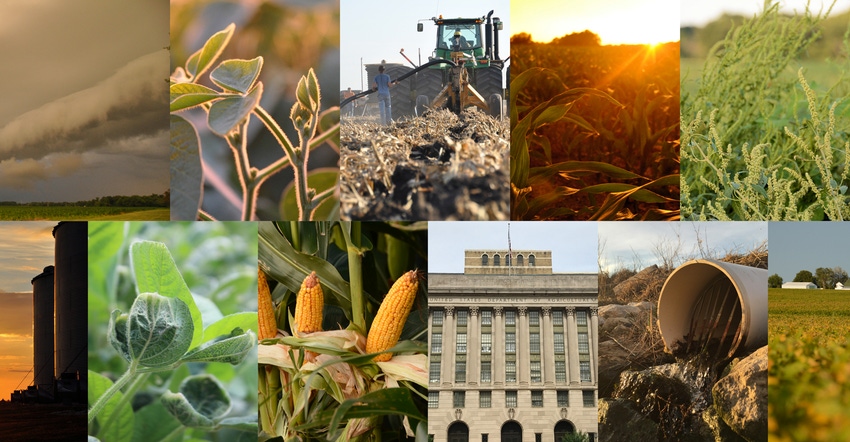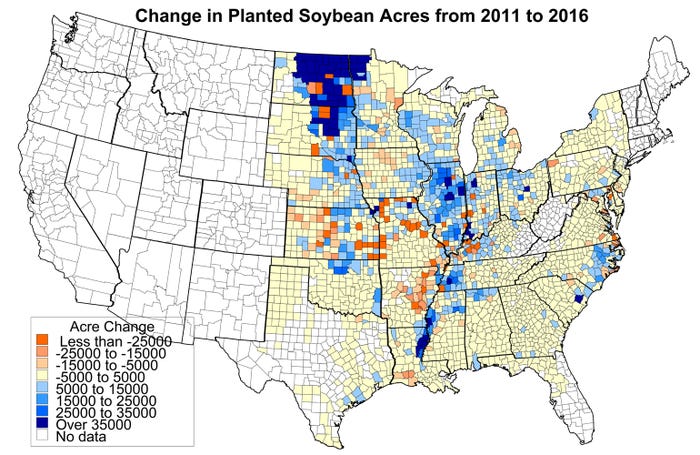
What are the smartest farmers you know doing differently in 2018?
That’s the question Prairie Farmer asked thought leaders all across Illinois agriculture, as the new year approaches. Their answer? Successful farmers in 2018 won’t pull off one big, major strategy; instead, their success will be the sum of a lot of small decisions — a series of strategies they’ll enact as they watch trends, working capital, owner equity, weather patterns and more.
Here’s a look at their list of the top 15 steps you can take to be better in 2018.
1. Watch the right weather. Eric Snodgrass, Agrible co-founder and atmospheric scientist at the University of Illinois, says growers should watch preseason drought in Texas, Oklahoma and Missouri. Snodgrass says 1988, 2002 and 2012 all had preseason drought near the Corn Belt that wasn’t resolved with April or May rains.
“If that drought survives May in those states, then it has historically spread north and east — which gets us,” Snodgrass says. “May is the pivotal month for moisture to set up through the growing season.” That’s because summer precipitation comes from hit-or-miss thunderstorms, where spring, fall and winter offer big low-pressure systems that give the whole state a drink. “If we don’t get big spring rains, we’re set up for hit-or-miss drought.”
2. Follow soybeans and total planted acreage. For the first time in 40 years, Snodgrass says there could be more acres in soybeans than corn. In 1990, U.S. farmers planted 75 million acres of corn; in 2017, they planted 90 million. Snodgrass says even if farmers plant 87 million acres of corn, they can’t match last year’s production. Upshot? A lot of old crop. Add in weather volatility, and you’ll take an already reduced-value crop and reduce what’s coming from the fields. “Seeing over $5 corn in 2018 is virtually impossible,” he says.
Watch USDA’s long-term projections through 2027, which puts corn acres down to 87.5 million and pushes soybean acres to 92 million. For comparison, 2013 soybean acres were at 77 million. That’s 15 million more acres — coming from the Dakotas, where wheat and barley used to be grown, and from every corner of Illinois, where Snodgrass expects another 25,000 to 30,000 acres per county.

PLAYERS: Who’s growing the soybeans now? The Dakotas are a major player in soybean production, as shown by this National Agricultural Statistics Service data.
3. Dicamba, take two. There were so many problems with dicamba products in 2017, it’s hard to pinpoint what went wrong in every field, says agronomist Karen Corrigan, McGillicuddy Corrigan Agronomics. If you plan to use Extend technology and dicamba, take a lesson from 2017: “Talk to your neighbors. Read the label. Talk to your insurance company. Attend the training. Clean your tank thoroughly before and after. Keep records. Document weather conditions. Know everything that’s expected of you.” Corrigan says a lot of farmers didn’t get covered by insurance this year, because they said it was volatility, not user error. “Weigh your risks vs. your rewards. It’s not a silver bullet — it’s a tool in your toolbox.”
4. Curb family living. Know your family living expenses, says Paul Stoddard, University of Illinois agribusiness. “It scares your accountant when you learn that from them.”
Dwight Raab, chief executive officer of Illinois Farm Business Farm Management, says to consider figuring family living on a per-acre basis. “How many dollars do you need per acre to support your family?”
Raab says FBFM data shows family living expenses climbed higher following 2006, and continued a slow climb through 2014, ’15 and ’16. They’ve leveled off since then, along with net farm income ($250,000 in 2012; down $3,000 in 2015; $90,000 in 2016).
5. Market smart. Bryce Knorr, Farm Progress marketing analyst, says after years of lower income and potential burned equity, look at where you’re at and use that to set marketing goals. “2018 could be a boom or bust year,” he adds. U.S. farmers have seen five years of above-normal yields; that doesn’t mean 2018 can’t be good (see No. 15). Another good year would send prices lower, because demand is not keeping pace with production around the world. “While demand may not change, production at some point will suffer. But we don’t know if that will be 2018, 2019 or when,” he says.
If your working capital is depleted and debt is rising, you have to limit how much money you lose — which could mean aggressively pricing 2018 crop, even at a loss, if it will keep you in business. Knorr says most farmers are in the middle and have already had opportunities to price 2018 crop for a profit, if they have average or lower costs and average or better yields.
Best line from winter marketing meetings? “Waiting for a drought someplace else is not a marketing strategy.”
6. Keep better records. Have record keeping that’s good enough to know where you are, Stoddard says. And do it on an accrual basis. Raab concurs; if you don’t know, you can’t measure, and you can’t control.
7. Be careful with beans on beans. Stoddard asks whether farmers will plant beans after beans for a third year (see No. 2). Agronomically, Corrigan says beans following beans is like any other crop on crop. Know how bad your soybean cyst nematode situation is, know your soybean pest levels, and use good seed treatment. “That’s not the place to cut money,” she says. Check pH; high pH creates problems in soybeans, like nutrient uptake. Be prepared for disease and pests, and scout well and often. Plan a robust preemergence herbicide program to knock down anything that’s out there. “The times of saving money on bean chemistries are over,” Corrigan adds. “Don’t cut rates, even if a label still has a half rate in front of a Roundup Ready crop.”
8. Control costs and maintain liquidity. Raab says the gas in your tank is working capital, which is figured by subtracting current liabilities from current assets. If you divide that by acreage, you get working capital per acre. Divide working capital by total expenses, and you get the percentage of your total expenses in working capital — which is your gas gauge. If it’s 100%, you have enough in working capital to finance next year’s crop expenses. Working capital has held its own since 2015, changing dramatically from 2012 to 2015. What can chip away at working capital? Family living (see No. 4), which circles back to Raab’s original point: Control costs.
9. Refinance with caution. Stoddard expects interest rates to bounce up, as expected for the fifth time in two years. That’s where your longer-term loans come into play. Adjustable rate loans are useful at this point only on a one-year operating loan, or perhaps a machinery loan.
10. Focus on weeds. Corrigan says untimely 2017 rains prevented a lot of farmers from getting preplant residuals on. Then when they could finally go, they skipped the burndown and planted instead. By the time they could spray postemergence, weeds were too big. Other fields started out clean, but then residual wore off during the summer dry spell. That means those escapes have left a lot of weed seed out there for 2018.
Corrigan’s advice: Have a strong preemerge burndown program, and be prepared to come in early postemergence when weeds are smaller and easier to control. “If Mother Nature allows us, we have to be more on top of controlling escapes from last year,” she says.
11. Pick the right anchor. “Anchoring” is a psychological term, but Snodgrass says it applies well to farming. “People anchored to yields from 2000, in the 160-bushel-per-acre range. They also anchor to corn prices from 2012. We have to allow ourselves to let our anchors move with the data.” The problem is when you anchor to those figures and get a USDA report. What should the anchor look like in 2018? Snodgrass says to look at corn production totals, not yield numbers.

TRENDS: USDA data on U.S. corn yields show a pattern of four years of above-trend yields. Will 2018 be year five? (See No. 15.)
12. Debts, assets: Know who owns what. Raab says debt-to-asset ratios are like an aircraft carrier: slow to turn. You won’t fix a ratio overnight, but what you do in the next three to five years will change it. In short, your debts divided by your assets shows what you owe your lender. Or in other words, it shows how much of your business your lender owns and how much you own. Lenders don’t like to be in a situation where they own more than you do.
13. Understand how the weather’s changing. First, Snodgrass says Illinois has seen a statistically significant change in rainfall patterns over the past 70 years. The state still gets 40 inches a year, but it comes in big events, followed by longer dry spells. That makes tile more important.
Second, Illinois has seen a 10- to 20-day increase in frost-free season length over the last 40 years. Farmers are planting really early soybeans in February and March and letting them stay dormant — as long as there’s no frost, they’re good. “We’re able to be more productive because the weather’s letting us do it,” Snodgrass says.
14. Push back on land costs. It’s difficult but necessary to negotiate hard on cash rents, though farmers don’t feel like they have options. “We have farmers out there trying to get the best possible price, not to maximize profit but to minimize loss,” Stoddard says, adding that some landlords just don’t understand the market. Cash rents that have already come down are likely to stay there now. Ones that have held steady will likely come down a little more.
Recent land sales came in over $12,000 an acre in Logan County, and over $13,000 and $14,000 in Sangamon County; two of those were 1031 exchanges. “Clearly the economy has recovered and commercial development has carried on,” he adds. It’s location-specific, but overall, land values are down 3% to 7% this year.
15. Know corn trends. Snodgrass says when you look at U.S. corn yields from 1980 to 2017, three time periods showed sustained above-trend yield: the late ’90s, the mid-2000s and the last four years. Six years is the longest those higher yields have lasted. “That’s not to say that the law of averages means that 2018 is bad,” he says. “But we shouldn’t be crazy surprised to have a 174-bushel national average.”
About the Author(s)
You May Also Like






